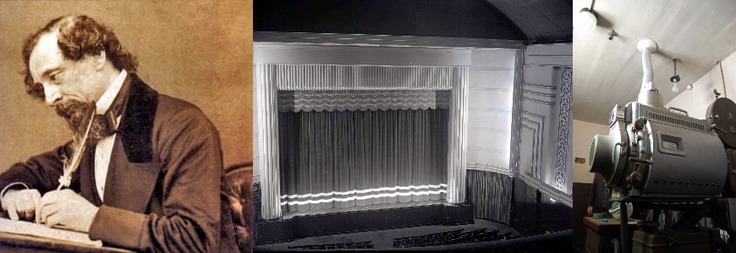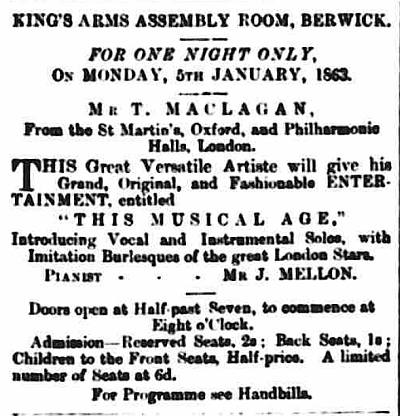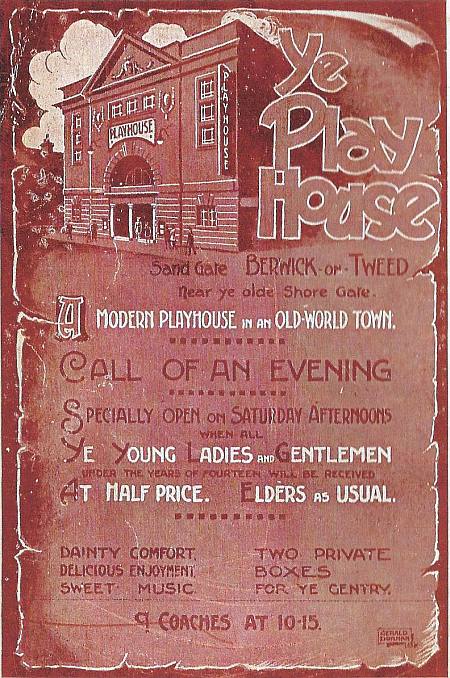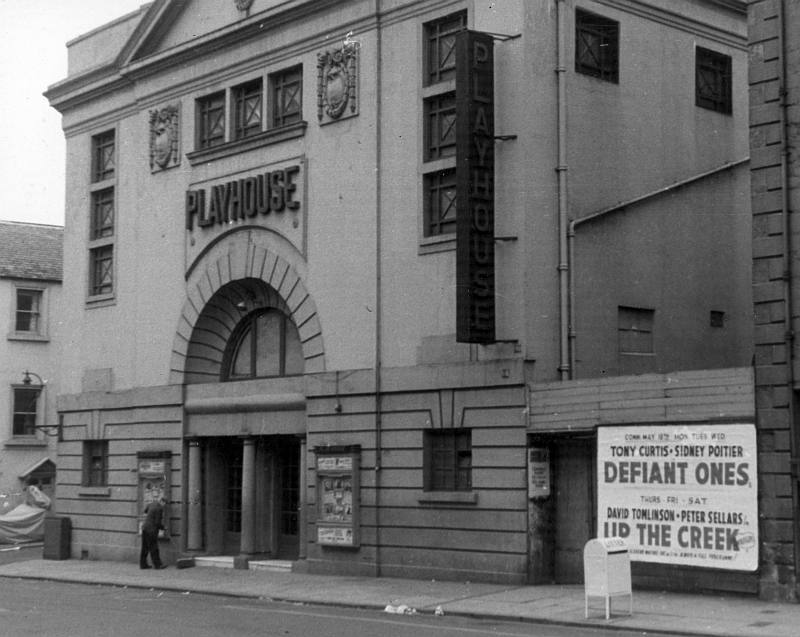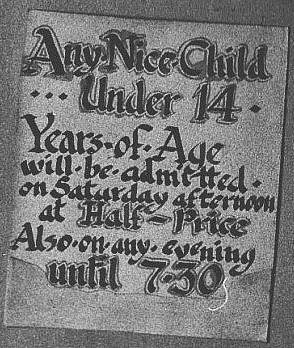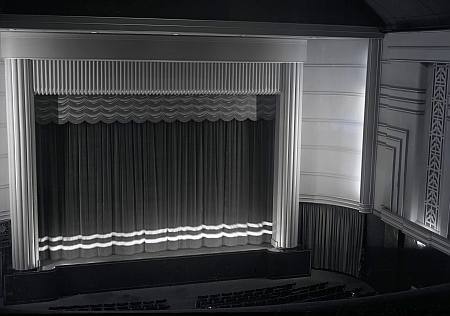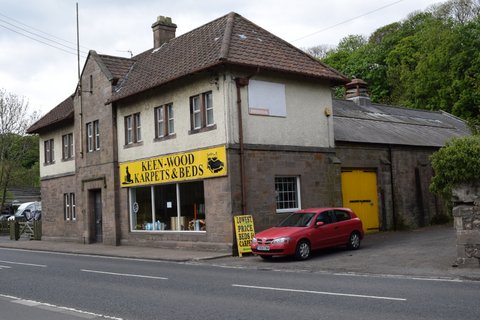The early history of theatrical performances in and around Berwick can be traced back to the mid-18th century when visiting companies would take over existing premises for their temporary purpose. John Fuller, in 1799, wrote: “Theatrical performances have occasionally been exhibited in Berwick for a great number of years past, sometimes in the Town Hall, and sometimes in a house in Golden Square.” (The History of Berwick upon Tweed. Edinburgh,1799. p. 450.) Berwick’s first dedicated theatre appeared in 1794. Stephen Kemble, then manager of the Theatre Royal in Newcastle and member of a prominent theatrical family, constructed it in the yard behind the King’s Arms on Hide Hill. This theatre “is usually opened a week before the commencement of Lamberton Races (held near 5 miles to the north of the town) in the first week of July, and continues so three or four weeks.” (Thomas Johnstone. The History of Berwick upon Tweed, and its vicinity. Berwick-upon-Tweed History Society, 2004.) This building was destroyed in a fire in January 1845.
King’s Arms Assembly Room
After the 1845 fire, the Assembly Room at the King’s Arms in Berwick, which survives to this day, was built on the site of Kemble’s theatre, and it served for a variety of purposes including balls, auctions, lectures, and public meetings; theatrical performaces may have been only an occasional event.
Meanwhile, in 1849 another theatre opened for a while in Upper Ravensdowne. “The building is an open court, nearly at the head of the street, and its character is indicated by a projecting gas lamp having engraven on its glasses the word ‘theatre’. The interior arrangements consist of boxes, pit and gallery, with orchestra and stage. None of these are very capacious but in harmony with each other; it is well lighted, by gas, and throughout papered and decorated, certainly in our opinion in a style more gaudy than neat… Though [it] is not all that we could desire our community to possess in the way of a habitation for the Muses, it may possibly rekindle the enthusiasm for theatrical amusements, and ultimately lead to something better.” (Berwick Advertiser, 13 January 1849, p.5.) It is unclear how long it continued in business.
In 1858 a company of actors from the Theatre Royal in Newcastle, managed by Messrs Courtenay and Ellerton, came to Berwick for a four-week season at the King’s Arms to coincide with the May Fair. The Berwick Advertiser reported: “We observe announcements placarded on the walls throughout the streets intimating that ‘the players are coming’, and for a short season the assembly-room at the King’s Arms will be converted into a theatre.” (BA, 29 May 1858, p.3) Even with a wide variety of plays and frequent changes of programme, the season appears to have had limited appeal in Berwick: “The theatre has been very indifferently supported, owing probably to the splendid weather we have experienced during the last few weeks; …’a beggarly account of empty boxes’ must exert a very chilling influence inside a theatre, and we hope, for the credit of the town, and not less for the amusement of the public, that the house will be crowded in future”. (Berwick Journal, 12 June 1858)
Although from this period onwards, the Assembly Room faced competition as a public venue from the new Corn Exchange, it received a dramatic endorsement in 1861 from Charles Dickens when he was staying at the hotel to give a lecture in the town (see the Corn Exchange, below). Dickens described the Assembly Room as “very snug” and “capable of holding 500 people”. And people arrived there in large numbers to hear him speak.
The Corn Exchange
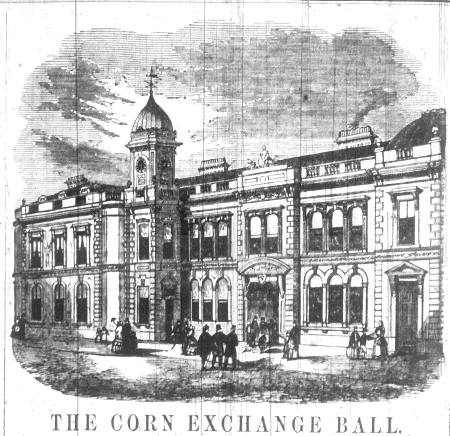
This engraving of the recently opened Corn Exchange appeared in the Berwick Advertiser on 4 December 1858 (Berwick Record Office).
The Corn Exchange opened on Monday 28 June 1858. It was designed by John Johnstone, a Scottish-born architect based in Newcastle.
“The Exchange is situated in Sandgate, and its lofty proportions at once arrest the attention of the passer by, and, with its dome-like roof and handsome corniced windows, [and] rich floral devices, imparts an imposing air of grandeur to the neighhourhood of its erection…. Its dimensions are 90 feet long by 70 broad. At one end is the gallery, calculated to hold about 300 persons, the hall itself accommodating 700…. At present one great drawback exists: the echo in the hall is considerable…. Irrespective of its object as a Corn Market, the hall is intended to serve the various uses of public meetings, concerts, lectures, dinners, and balls; and a platform, it is understood, will also be provided, as an additional [sic] for stage performances.” (Berwick Journal, 3 July 1858)
Charles Dickens was due to lecture at the Corn Exchange in 1861, but the author was not impressed with the facilities. Writing about Berwick from his room at the King’s Arms an hour before his reading, he said: “As odd and out of the way place to be at, it appears to me, as ever was seen! And such a ridiculous room designed for me to read in! An immense Corn Exchange, made of glass and iron, round, dome-topp’d, lofty, utterly absurd for any such purpose, and full of thundering echoes; with a little lofty crow’s nest of a stone gallery, breast high, deep in the wall, into which it was designed to put – me! I instantly struck, of course, and said I would either read in a room attached to this house [i.e. the King’s Arms] … or not at all.” (John Forster. The Life of Charles Dickens; ed. by A.J. Hoppé. London: Dent, 1966. Vol.2, pp.241-242.)
Despite any shortcomings, the Corn Exchange became a principal venue for many kinds of performances at least until the First World War, especially for musical events, performed either by local people or by touring companies, though less frequently for theatrical shows. From 1898 some of the earliest cinema screenings in Berwick were presented at the Corn Exchange (though the very first of these was actually at the Queen’s Rooms – see below). Initially moving pictures were often shown in the context of illustrated lectures about foreign travels or reports of news events such as the great London procession for Queen Victoria’s Jubilee or the progress of the Boer War. It was also common for short films to be included in touring variety shows alongside singers, magicians and acrobats, and they were also incorporated into the visual spectacles of Poole’s Myriorama which visited Berwick on several occasions.
|
THE HISTORY OF THE CORN EXCHANGE in Berwick during the 19th century can be followed in a series of transcripts of articles and advertisements from the Berwick Advertiser, alongside a narrative history for the period 1856-1895.
Click the link above to see the index of downloadable PDF files.
|
The Queen’s Rooms
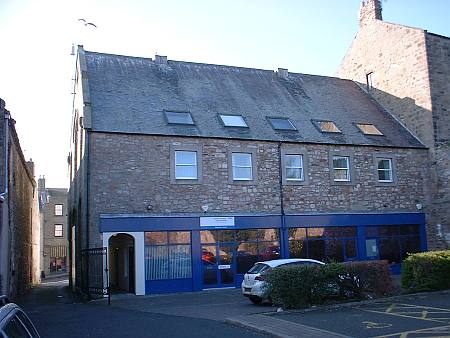
This photograph of Anderson’s Court, formerly the Queen’s Rooms, was taken in 2012. In the upper right corner can be seen the side of the King’s Arms Assembly Rooms which it abuts. On the extreme left of the picture, the side of the Salmon Inn Hall, probably used afterwards as the Central Picture Hall, is visible (but now demolished). Photo © FBDMA.
The Queen’s Rooms seem to have been constructed in the late 1870s, just behind the imposing Queen’s Buildings on Hide Hill. From 1879 onwards the hall was used for public meetings and entertainments; in June 1888 it was being used by Spittal Amateur Dramatic Society. When the Queen’s Buildings were offered for sale in 1889, the advertisement included the following reference to the hall which was to be included in the transaction: “the well-known ‘Queen’s Rooms’, with spacious public hall, licensed for stage plays, and presently used for theatricals, assemblies, concerts &c, with retiring rooms attached”. (Berwick Advertiser, 4 October 1889, p.2.)
On 10 February 1897, the first screening of moving pictures in Berwick took place in the Queen’s Rooms. The Modern Marvel Company of T.J. West was one of the earliest touring companies to introduce the “cinematograph” to towns and villages in Scotland and the North of England, and they brought their demonstration to Berwick just one year after the first British film screenings in London. (Berwick Advertiser, 5 February 1897, p.1)
Film screenings continued here intermittently until the early 1920s, though the venue was principally used for other public events.
Although the Queen’s Buildings on Hide Hill were demolished in the 1920s, the Queen’s Rooms survive today under the name of Anderson Court, providing office accommodation.
|
“BERWICK SILENTS“ is a history of early cinema in Berwick, from 1895 to 1930.
Downloadable from this link as a PDF file.
|
The Central Picture Hall
Until 1909, the visiting filmshows in Berwick appeared either at the Queen’s Rooms or at the Corn Exchange. However in November 1909 a new venue was announced, the Central Picture Hall, seemingly intended to serve as a dedicated auditorium for showing films. It was situated at 53 Hide Hill (thus lying between the Queen’s Rooms and Silver Street).
The initial advertisements declared: “The [Central Picture Hall] will be opened as a Picture Palace on November 22nd. After extensive alterations — A most up-to-date Series of Cinematograph Pictures will be shown, together with vocal and other variety turns. Don’t forget the date. Twice nightly at 7 and 9. Prices of admission 2d, 3d, and 6d. Tom Gilbert, Manager.” (Berwick Journal, 11 November 1909, advert)
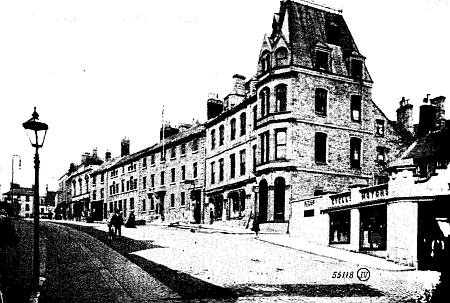
This early 20th century picture of Hide Hill shows, at the extreme right, the entrance to the A&B Garage behind which was the Central Picture Hall. The tall building behind it is part of the Queen’s Buildings (demolished in the 1920s). (Source unknown)
The Berwick Journal then reported: “The Garage Hall which has been acquired by the Central Picture Coy., with Mr Tom Gilbert as manager, was opened as the Central Picture Hall on Monday night…. At both exhibitions on Monday night the audiences were numerous.”
The old Salmon Inn Hall, above the Alnwick & Berwick Garage & Cycle Co. which opened around 1907 on the corner of Hide Hill and Silver Street, seems to be the likely location of this venue. It was demolished in December 2015.
The series of programmes at the Central Picture Hall ran from late November 1909 until early March 1910. However, when film programmes resumed in the autumn of 1910, they were once again at the Queen’s Rooms and the Corn Exchange. There is evidence of just one further use of the Central Picture Hall for film projection, in the month of July 1911, with a programme including a film of the Berwick May Fair, as well as the Coronation procession in London (George V was crowned on 22 June 1911). The film of the May Fair is the earliest known film of Berwick that survives; it includes scenes of the horse judging in The Parade, and a procession down Hide Hill. (A copy of the film is held by Berwick Record Office.)
The Playhouse
The growing popularity of the cinema produced a demand for dedicated premises in which to show films, and a wave of purpose-built ‘picture palaces’ appeared around the country during the years leading up to the First World War. In May 1913 it was announced that a permanent cinema was to be built on a site in Sandgate in Berwick. The Playhouse opened for business a year later on 22 May 1914, under the ownership of a company called Pictureland (Berwick) Limited, in which there were a number of local shareholders.
The local papers reported approvingly of the new building’s design and decor. “Externally, the ‘Playhouse’ enhances the appearance of Sandgate; internally it is comfortable, well-lit, excellently ventilated. The seating accommodation is of city standard…” (Berwick Journal, 28 May 1914, p.8). “Three huge cement plaques, representing dolphins, mouths agape, adorn the front of the walls…. The whole scheme of decoration in the hall is after the style of Wedgwood, blue and white… Gold and crimson curtains…” (Berwick Advertiser, 8 May 1914, p.6).
Now films could be shown all year round on six nights a week (with the occasional variation of vaudeville shows) in a theatre which could accommodate over 1000 people – an astonishing figure when one surveys the limited dimensions of the site today. The launch of the Playhouse sought to emphasise the respectability and high quality of its presentations – with lady attendants in Quaker uniforms, a front-of house commissionaire, and a house orchestra (Berwick Advertiser, 22 May 1914, p.2).
Within three months of the opening of the Playhouse, the nation was at war with Germany, and cinema managers were quick to see the opportunities which it gave them to establish a new and patriotic relationship with the public; newsreels and war-related features rapidly became part of the programming. The Playhouse survived the disruption to the film industry which the prolonged war brought about, and it continued to be Berwick’s principal venue for films until 1928 when The Theatre opened and gave it some competition.
The Playhouse continued to function as a cinema, while sometimes offering live theatrical performances as well, until 2005; the building was demolished at the end of 2010.
The Theatre
Berwick’s second cinema opened for business at the start of February 1928. As its name suggested, The Theatre, at the upper end of Hide Hill, was designed to allow both film and stage performances (like the Playhouse), and it also incorporated a café. It was described as follows:
“The whole building is in Greek design and constructed in artificial stone. On the front on Hide Hill there is an entrance loggia, the four square columns of which are faced with terrazza work…. The area [i.e. stalls] of the Theatre … seats 754, tip-up seats being provided…. The stage measures 26 feet by 54 feet in width…. The stage is fitted with every modern equipment for lighting effects, special limelight galleries being provided. The projection from the cinema apparatus is from the rear of the curtain, the apparatus itself being in a fireproof building outside the theatre, and can be cut off immediately by means of a steel shutter in the event of an outbreak of fire. A further safeguard against fire is the asbestos curtain which is fixed in heavy steel frames and works in specially constructed steel sockets, completely cutting off the stage from the area. In front of the stage is the well for the orchestra. The balcony seats 271, the total seating accommodation of the theatre being 1025. Here plush-covered, tip-up seats in deep rose shade are provided. The colour design of the theatre walls is buff and green with gold touches.” (Berwick Advertiser, 26 January 1928, p.7)
The opening of The Theatre coincided with the advent of the first talking pictures, though it took some time for smaller regional theatres to gear themselves up with the necessary sound equipment to show them. In Berwick it was The Theatre which first took up the challenge, and during the summer of 1929 a sound system was installed and the first sound pictures were added to its programmes. (The Playhouse caught up with its own sound equipment in November 1929.)
The Theatre remained in business as a cinema, and for live theatre performances as well, for four decades, and its last screening was in January 1969. In its subsequent history it has been a nightclub – “Caesar’s Palace” in the 1970s – and a bingo hall. (Cinema actually returned to Caesar’s Palace for a couple of years in the early 1970s when The Playhouse closed for refurbishment.) In 2015 the building was redeveloped to house a combination of a restaurant, a shop, and residential accommodation.
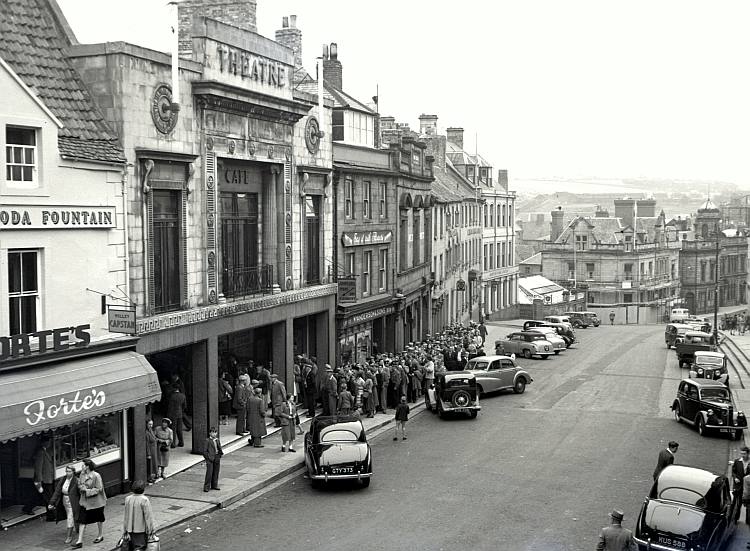
This photograph of people queuing for entry to The Theatre was taken in the 1950s. (Berwick Record Office BRO 1944-1-995-1)
The Drill Hall, Wooler
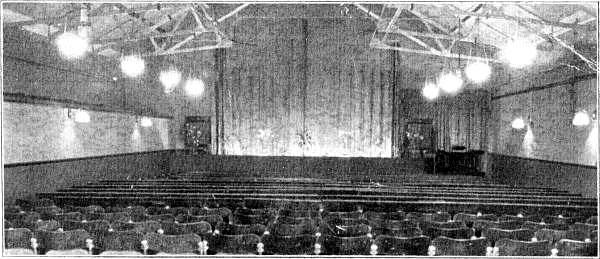
This picture of the interior of the Drill Hall cinema shows its substantial scale. (From Views of Wooler and Glendale District 1850-1950, by Derek Fairnington and Roger Miket. Wooler: Maclean Press, 2004.)
Until 1922 local companies showed films in Wooler on an occasional basis in venues such as the Archbold Hall. In 1923 the Drill Hall, which had been built just before the outbreak of WW1 as a training venue for the 7th Northumberland fusiliers, was purchased by the firm of J. Redpath & Sons and it was fitted up with cushioned tip-up seats to serve as a dedicated cinema. An arrangement was made with the Princess Electric Cinema Company to provide the programme of films. (Berwick Advertiser, 8 June 1923, p.3)
At the end of the 1920s when silent films were giving way to talkies, the Drill Hall was no longer equipped to handle the new medium and the cinema closed for a few years. Audiences were tempted further afield to cinemas showing sound films, and Wooler tradesmen began to complain that the Saturday cinema exodus was affecting their business.
In the autumn of 1933 public meetings were held to discuss reviving a picture house in the town, and both the Drill Hall and the Archbold Hall were considered as possible venues. In the event, a licence was granted to Fred Wilcox of Alnwick to show films at the re-equipped Drill Hall. (Berwick Advertiser, 21 Sept., 5 Oct., 9 Nov. 1933). This arrangement was taken over a couple of years later by James Redpath jr., who continued to manage the cinema through the war years and beyond. (Redpath also opened cinemas in Coldstream, Melrose, and Eyemouth.)
Over the years the Drill Hall cinema was known by various names, including the Wooler Cinema, the Eildon Cinema, or just “the Picture House”. By the early 1960s it was, like many others, struggling to retain its audiences, and in September 1961 it closed for the last time.
The Drill Hall still stands today on South Road, having served various businesses in subsequent years and now housing a carpet shop.
The Maltings
The Maltings opened on 4 April 1990. It was designed as a purpose-built arts complex, built in the centre of the town on the site of an early 19th century maltings which had been destroyed by a fire in 1984. It has a main theatre seating around 300 people, and a flexible studio space which can seat around 70 people; there is also a café and a bar and a number of meeting rooms. Its programme includes both cinema and theatre, and other live events.
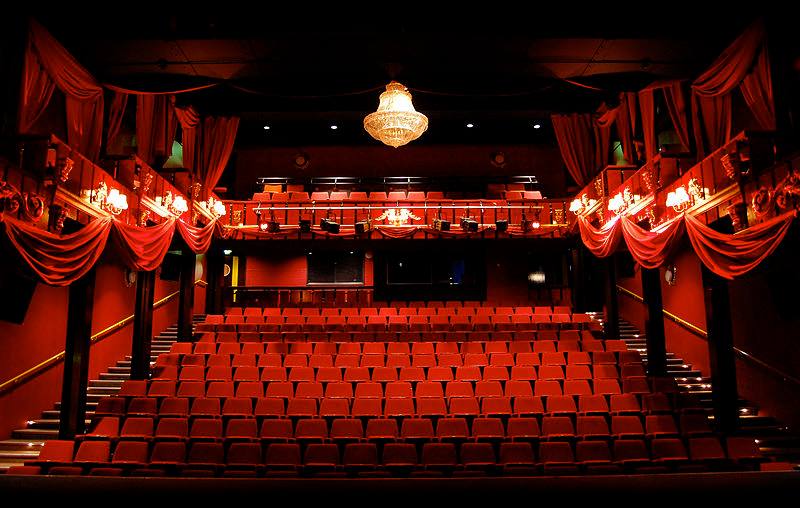
The main auditorium at The Maltings. (Photo: Maltingsberwick [CC BY-SA 3.0 or GFDL] via Wikimedia Commons)
Banner images: Charles Dickens (Wikimedia Commons); The Theatre (Berwick Record Office BRO 1944-1-647-3); Playhouse film projector (unknown source).
https://www.berwickfriends.org.uk/history/corn-exchange/

